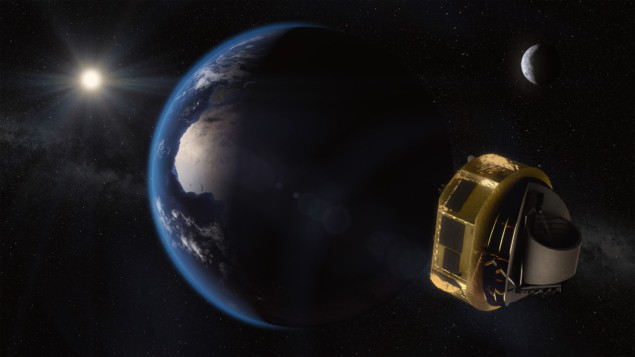
The European Space Agency (ESA) has announced it will launch the first probe dedicated to studying the chemistry of exoplanet atmospheres. Costing €450m, the Atmospheric Remote‐sensing Infrared Exoplanet Large‐survey (ARIEL) mission will launch in 2028 and will observe 1000 exoplanets over a four-year period.
ARIEL beat off two other missions vying for ESA’s latest “medium-class” launch slot. One was the Turbulence Heating Observer, designed to study the interaction of the solar wind with Earth’s magnetic field. The other was the X-ray Imaging Polarimetry Explorer to investigate X-ray emissions from high-energy sources such as supernovas, galaxy jets, black holes and neutron stars.
ARIEL will be launched from French Guiana by an Ariane 6-2 rocket and will be placed at Lagrange Point 2 – a gravitational balance point some 1.5 million kilometres beyond the Earth’s orbit around the Sun. The location will also be home to the James Webb Space Telescope, which is currently set to launch in 2019.
Ariel is a logical next step in exoplanet science
Günther Hasinger
From there ARIEL will study exoplanets that range in size from Jupiter to Earth focussing on hot planets that are in orbits close to their stars. Such intense temperatures keep molecules circulating in the atmosphere and stop them forming cloud layers where they are harder to detect remotely. ARIEL’s 1.1 x 0.7 m primary mirror will collect visible and infrared light while its spectrometer will determine the various gases in a planet’s atmosphere. A photometer will capture information about the presence of clouds and help to point to the target star with high precision.
“Although we’ve now discovered around 3800 planets orbiting other stars, the nature of these exoplanets remains largely mysterious,” says astronomer Giovanna Tinetti from University College London, who is ARIEL’s principal investigator. “ARIEL will study a statistically large sample of exoplanets to give us a truly representative picture of what these planets are like. This will enable us to answer questions about how the chemistry of a planet links to the environment in which it forms, and how its birth and evolution are affected by its parent star.”
Understanding Earth’s place in the universe
ARIEL has been developed by a consortium of over 60 institutes from 15 countries belonging to ESA. “Ariel is a logical next step in exoplanet science, allowing us to progress on key science questions regarding their formation and evolution, while also helping us to understand Earth’s place in the universe,” says Günther Hasinger, ESA’s science director.
ARIEL will now join a number of dedicated exoplanet missions that will launch in the coming decade. Next month, NASA is expected to launch its Transiting Exoplanet Survey Satellite, which will survey the brightest stars near the Earth for exoplanets over a two-year period. ESA, meanwhile, will launch a small mission to study exoplanets – Characterising Exoplanet Satellite – later this year as well as an exoplanet observatory, dubbed Plato, in 2026.



